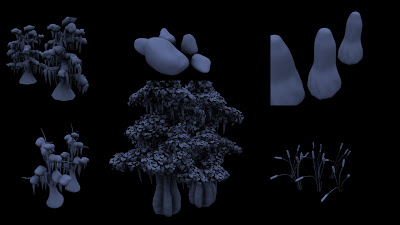To achieve the 3-D water, the effects team decided to use Maya and Houdini for appropriate shots.
Maya - for short, non-complex water shot.
Houdini - for longer, more complex water shot (with ripples and sprays)
First, the work-flow of exporting and importing file between Maya and Houdini was established and documented by Garrett.
1) Export necessary models from Maya file as FBX.
2) Import to Houdini as filmbox FBX, work the water simulation.
3) Export the water simulation done in Houdini as RIB.
4) Import to Maya as RIB, now it's ready for lighting.
After the selection of water effect shots was made, most of the file conversion to FBX from Maya (step 1) was done by Yuriya. And she tracked the shots that were missing or in need for update through the quarter.
Once the FBX was ready to be imported to Houdini, Charles, made a template file in Houdini for water simulation. The water effect team then used the template to complete the water simulation.
Comment from Charles:
During Milestone 2, I developed a water simulation template for Houdini. I also took some time to revise it and added some features during Milestone 3. The idea of having a water simulation template is that we can have a single file already set up with all the bells and whistles Houdini uses to make particle and ripple simulation possible.
With this file, we can just drop in animated alter values which pertain to the simulation that I placed in a single node in the root that links up to values found within the node network and easily come up with simulations that would take much longer to set up on a per-shot basis. This simulation template performs a ripple simulation on a deforming plane surface, as well as generates a blobby mesh based on particles which provides water kick-up.

1) Simulate ripples

2) Adjust the ripple mesh

3) Particle spray simulation

4) Adjust particle mesh.

5) Export the ripple & spray simulation as RIB
Results (by Charles)
TESTS
TEST 01
TEST 02
Shot 53


























































